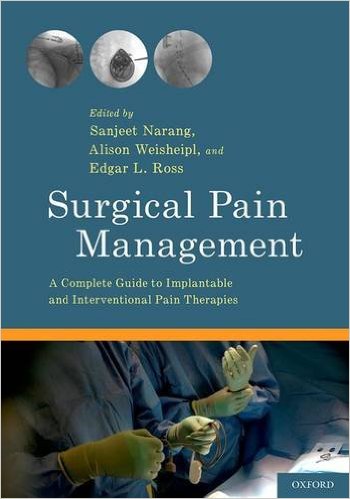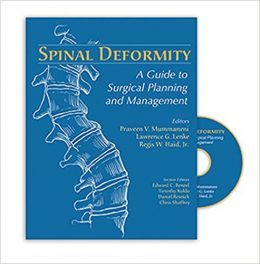Editors: Sanjeet Narang, MD; AlisonWeisheipl, MD; and Edgar L. Ross, MD
Publisher: Oxford University Press – 389 pages
Book Review by: Nano Khilnani
There are no universally effective treatments for chronic pain. The editors point out however that in recent decades, many minimally invasive surgical techniques have come into wide use for reducing pain to some degree, and hold much promise for even greater pain reduction.
Two of these techniques are spinal drug delivery and spinal cord stimulation that have helped many patients, who had suffered from chronic pain, regain some form of a normal life, with less pain.
But information about these and other pain-reduction methods was not available in a single source. That is the reason this book was developed. It provides comprehensive knowledge and the collective experience and insight of over forty healthcare professionals involved in pain alleviation.
Among other features and benefits this work provides you – the surgeon or physician, medical resident or student, nurse or other health worker, are that you will learn:
- How to select appropriate patients to receive these pain-alleviation treatments
- How to assemble the extensive support necessary to incorporate these treatments into a comprehensive pain-reduction program
- How to master the technical details of device placement
Forty three doctors and others in healthcare, including the three editors named above, with most of them being professors and / or practicing specialists in anesthesia, general surgery, implantation, neurosurgery, and pain medicine, wrote the 16 chapters of this compact paperback focused on the mission of imparting knowledge on how to reduce pain for patients, mainly by implanting drug delivery systems.
Below is an overview of the topics you’ll find covered in this book, with titles of the chapters below:
- Part I – Foundations of a Surgical Pain Management Team
- Organization of an Implant Service
- Anesthetic Management for Chronic Pain Surgery
- Psychological Evaluation of the Surgical Pain Patient
- Patient Education for Surgical Interventions for Pain
- Part II – Surgical Procedures and Operations
- Implantable Drug Delivery Systems
- External Epidural Infusion Systems
- Dorsal Column Stimulation
- Peripheral Nerve Stimulation
- Craniofacial Nerve Stimulation
- Field Stimulation
- Sacral Nerve Stimulation
- Treatment of Discogenic Pain: Minimally Invasive Procedures
- Vertebral Augmentation
- Minimally Invasive Treatments for Spinal Stenosis: Percutaneous Lumbar Decompression
- Endovenous Ablation
- Deep Brain Stimulation in Refractory Chronic Pain
The subspecialty program in pain medicine at Brigham and Women’s Hospital has been internationally recognized as one of the best in the world. The three editors of this book have all received training in this field and work there.
Readers are alerted to take note that the surgical and invasive treatments of pain presented and discussed in this valuable book, which are advanced and expensive, are mainly for those patients who have not been able to be helped by “conservative measures,” Dr. James P. Rathmell points out in his Foreword to this book. These special treatments however, can be part of a comprehensive pain management plan that involves other options.
Separately, Dr. Edgar L. Ross writes in his Preface that one out of every three Americans suffers from chronic pain and its cost in the United States healthcare system exceeds that of treating cancer, diabetes, and heart disease combined! He cites as his source a 2008 research study entitled The Economic Costs of Pain in the United States authored by Darrel J. Gaskin and Patrick Richard in the book Relieving Pain in America.
In that study, the Medical Expenditure Panel Survey (MEPS) stated that some 100 million adults (18 and over) in this country were affected by chronic pain including abdominal pain, arthritis or joint pain, back pain, chest pain, and headache. It went on to state that such pain restricts their ability to work, adversely affects their quality of life, and complicates medical care for other ailments.
The total economic cost to the U.S. economy, which consisted of the cost of medical care, and loss of hours and days of work, amounted to between $560 billion and $635 billion in 2010 dollars.
Editors:
Sanjeet Narang, MD is Assistant Professor of Anesthesia in the Department of Anesthesiology, Perioperative and Pain Medicine at Brigham and Women’s Hospital and Harvard Medical School in Boston, Massachusetts.
Alison Weisheipl, MD is Instructor in Anesthesia in the Department of Anesthesiology, Perioperative and Pain Medicine at Brigham and Women’s Hospital and Harvard Medical School in Boston, Massachusetts.
Edgar L. Ross, MD Associate Professor of Anesthesia in the Department of Anesthesiology, Perioperative and Pain Medicine at Brigham and Women’s Hospital and Harvard Medical School in Boston, Massachusetts.






